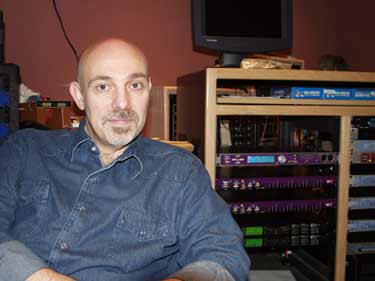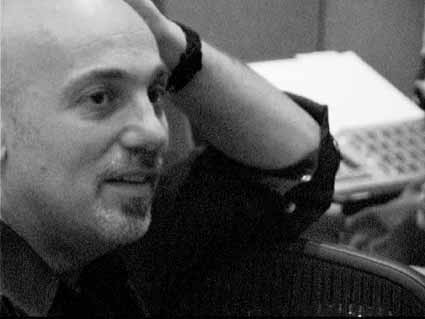|
joe chiccarelli Engineer / producer joe chiccarelli started working with Frank Zappa in the late seventies. The first concert he recorded for Zappa was the 1978 halloween concert.
|
 |
|
joe chiccarelli Engineer / producer joe chiccarelli started working with Frank Zappa in the late seventies. The first concert he recorded for Zappa was the 1978 halloween concert.
|
 |
discography
|
71 |
frank zappa: halloween (2003, dvda, usa, dts entertainment 69286-01101-9-9) - sound engineer |
random notes
The following article appeared on the apogeedigital website a couple of years ago: Joe Chiccarelli on reworking the 1978 halloween concert for a DVD-audio release:
Joe Chiccarelli: Mixing Zappa in 5.1
for Hallowe'en
DTS Entertainment Creates Exclusive DVD-Audio Release - with Apogee
by Richard Elen
He's worked with Tori Amos. Beck. U2. Shawn Colvin. Bon Jovi. Café Tacuba. Elton John. Melissa Etheridge. Even the Kronos Quartet. And then there's Frank Zappa. Here's what top engineer/producer Joe Chiccarelli was working on when we caught up with him in Capitol's Studio C in Hollywood recently: live Frank Zappa tapes from Hallowe'en 1978, recorded at the Palladium in New York. And he's doing it with Apogee: DA-16s for playback, AD-16 for the 5.1 mix (with Steinberg's Nuendo, effectively completing the NativeTools package) and Trak2 for the stereo.
It's a cool project to be working on. The DVD-A will be released by DTS Entertainment later this year, and the audio portion of the disc is being produced by Rory Kaplan of DTS and Dweezil Zappa. Working with them is Capitol's Steve Genewick.
Boston-born Chiccarelli is not only mixing it: it turns out it was the first live recording he ever made, soon after he had started working with Zappa in the late 70s. Chiccarelli had moved West and was working in LA's Cherokee Studios when he landed his first gig with Zappa, engineering the album Sheik Yerbouti and subsequently several other Zappa discs. And this live project.
The show was recorded on 16 reels of 24-track analog, recorded on an Ampex MM1200 in Dave Hewitt's mobile truck. "It was a great show," Chiccarelli recalls. "All the classics are there: Camarillo Brillo, Dinah Moe Humm, Yellow Snow..."
The original 24-tracks were replayed from a Studer A800 and transferred into Nuendo for the mix - it's the preferred system at DTS - with two Apogee DA-16 D/a converters being used to replay the tracks into Studio C's Neve VRQ72 with Flying Faders.
"The DA-16s make an impressive difference," says Joe. "There's way more fullness and punch - Apogees are very punchy-sounding converters," he goes on. "The size of the record increased by two thirds when we patched them in, and the bottom end is much, much deeper," he says. "The way I'd put it is that when we plugged the Apogees in, it instantly felt like the original sound off the board in the truck back in 1978," he comments. "From what I remember from 25 years ago, of course!" He also found the light-pipe S/MUX hookup very straightforward. "It was very easy to set up," he notes.
The 5.1 mixes are being recorded on 2in 8-channel analog tape, and at the same time back into Nuendo via the Apogee AD-16 at 96 kHz. In addition, Joe is using a Trak2 to convert the stereo mixes that will also appear on the DVD-A release. "The Trak2 is great - i've used it before," says Chiccarelli. "It's invisible, it just sounds like the console," he continues. "Considering there's just one knob, and it does all that stuff, it's really easy to use - just 20 minutes with the manual and I was away," he notes. "I'm not using the mic pre on this project, but I've used it on other recordings and it's very clean, real and honest."
He goes on, "Apogees sound fuller, punchier. There's no low-end scoop, no weakness in the lower bottom end, they're very honest," Chiccarelli goes on. "Hall ambience sounds are realistic, and the kick and bass sound punchier, not weak like you get with some converters." Chiccarelli is a Pro Tools user too, and he is eager to try the AD-16 and DA-16 on his HD system. He already knows that his AD-8000 Special Edition sounds great with Pro Tools.
I asked him how he tackled the surround mix for the Zappa project. "It's a challenge to take something made as a stereo recording and remix it into 5.1," he comments. "For example, there are only two tracks of audience, and they have quite a lot of compression on them. Frank's vocal has a lot of audience on it, too, so it's difficult to separate that out," he concludes.
Despite the challenges, it sounds like it's going to be a killer album, and I, for one, will be looking out for it later in the year.
|
Universal Audio WebZine Analog Dialog: The Kind Producer, Joe Chiccarelli --Interview by Marsha Vdovin |
|
| The Nicest Producer/Engineer in
Popular Music Talks Shop The stereotype we tend to have of the recording engineer is the quiet serious character hunched over the mixing board grunting answers. Joe Chiccarelli sure cancels out that preconceived image! We were first introduced at AES 2002 by Bill Putnam Jr. and then ran into each other again at the Surround 2003 conference. He is an extraordinarily friendly, outgoing and social guy. Our mutual friend, the legendary guitarist Joe Gore, says, “Joe Chiccarelli never has a bad word to say about anyone.” I even tried to bait him with Courtney Love and all he said was, “I worked with her for a couple of days and she was very nice and professional.” Sheesh…Everyone has a Courtney horror story… |
 |
|
Joe is well known for having worked with Frank Zappa at a young age and recently did an amazing job remixing the Zappa Halloween LIVE album in 5.1 surround for DTS Entertainment. Dweezil Zappa tapped Joe to remix the live show that Joe had originally recorded in 1978. People often focus on the Zappa work in interviews, but Joe’s engineering, mixing and producing credits are quite varied and eclectic. He’s worked with Beck, U2, Elton John, The Stranglers, Shawn Colvin, Rickie Lee Jones, Kronos Quartet, Cafe Tacuba, Lamb, The Offspring and some of my favorite records by American Music Club (that still make me cry.) Joe is excited about new releases that come out in March from new Warners’ artist Mandy Kane as well as a new independent artist named Peter Walker. Joe and I got together recently for a chat when Joe was in San Francisco mixing some songs for the new Vanessa Carlton record. He’s such a nice guy he shared some of his secret techniques with me. Joe Chiccarelli owns several vintage UA hardware units, an LA-2A, a couple of LA-3As and a couple of 1176s but he has worked with many of the new units as well. Does he see a difference between the vintage units and the reissues? “They are slightly different. I think the new hardware is subtly different and there’s pluses and minuses. To be honest, I think the new stuff is cleaner, quieter and retains more high fidelity than the old stuff. I think the old stuff has more distortion and color. Some times I like the new hardware more and sometimes I prefer the old hardware. I find that the new 1176s are better for vocals because the old ones are grittier. The new ones are cleaner, more open, and just sweeter on tape.” “The new LA-2As don’t darken as much as the old ones. When you compress the old LA-2As a lot, they get really dark, which is kind of cool sometimes and works in your favor. If you have a vocalist that’s really harsh and has a lot of dynamic range, when they get up in the upper register they can get a little nasty sounding. If you get a compressor that kills that a little, it works in your favor. But other times you may have a vocalist that you just want to compress a tiny bit, but all of sudden they hit a peak… you lose a little air on the top end. The new ones don’t do that as much. The time constants are a little different is my guess.” “I don’t’ want to dissuade anyone from buying a new unit because I think they are really cool. I’ve been mixing a couple of projects on new units recently. I always use them on vocals. When I’m mixing, I’ll usually have an LA-2a or LA-3A on the vocal on the insert and I’ll compress a little (2 or 3 db) but then I send it via a bus to an 1176. It’s always an 1176, and I compress it a fair amount and blend a tiny bit of that in with the relatively uncompressed vocal and that helps sort of beef it up a bit without sounding too compressed. The only thing I found that works is the 1176 because it does seem to fatten it up and give it some character. It seems to help hold the vocal up there really big in the track. I’ve tried it with other things like a vocal compressor or DBX and nothing works quite the way that the 1176 does. So for this kind of ‘double buss compression’, I think the 1176 works perfectly.” Joe is building a personal studio at Cello (formerly Western Recorders) in LA. Why there? “That’s my favorite studio in LA, actually one of my favorites in the world. Because it was designed by Bill Putnam Sr. I find that Putnam-designed rooms sound incredibly natural and are embarrassingly easy to record in. For my taste, Cello studio 1 is the best. You can put up any microphone in that room and it just sounds great. And I’m talking about either a rock band or an orchestral recording; it just sounds great in that room. No matter what you do in studio 1, I just love the way it sounds. And that goes for all of his rooms, there’s just something natural about the ambience. It just seems that the approach he took to building all those rooms was very smart, and I know nothing about his design philosophies. It just seems like he paid some attention to some basic acoustic principles and then made sure that instruments sounded like they were supposed to in the room and that’s the first step for any great recording is that the instruments have to sound in their natural environment before you even turn a microphone.” And of course, Joe is going to be buying some UA hardware to add to the arsenal for his new room at Cello. --Interview by Marsha Vdovin |
|